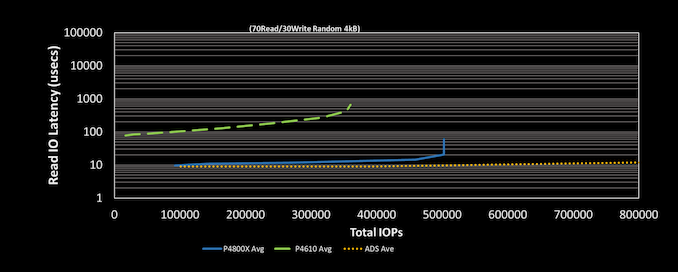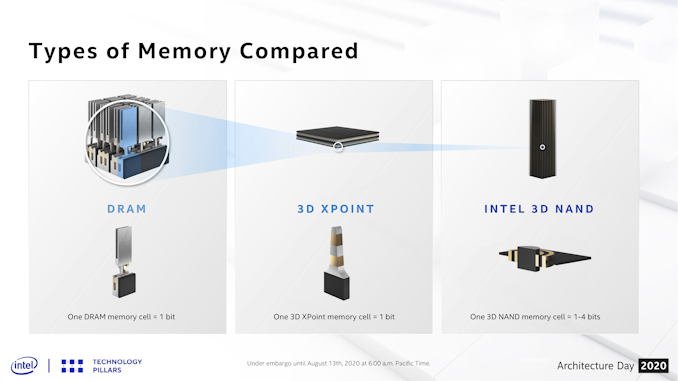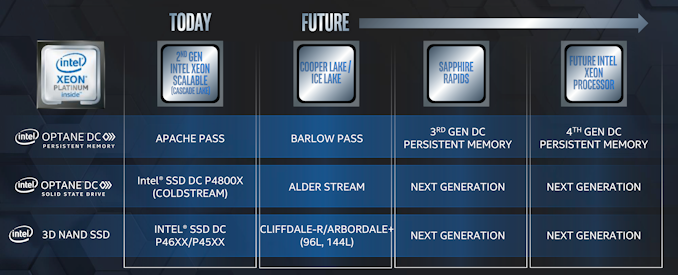Intel Previews 4-Layer 3D XPoint Memory For Second-Generation Optane SSDs
by Billy Tallis on August 13, 2020 9:10 AM EST- Posted in
- SSDs
- Storage
- Intel
- NVMe
- Optane
- PCIe 4.0
- Optane DCPMM
- Intel Arch Day 2020

As part of Intel's Architecture Day 2020 presentations, Raja Koduri spent a bit of time talking about the status of their Optane products. Most of it was a recapitulation of details Intel has previously shared. The two important Optane product updates planned for this year are the Barlow Pass second-generation Optane DC Persistent Memory Modules (DCPMM) and the Alder Stream second-generation Optane NVMe SSDs.
Intel has been teasing their Alder Stream second-generation Optane SSDs since last fall, with promises of off-the-charts performance increases. They've confirmed that Alder Stream will be using second-generation 3D XPoint memory, which moves from two to four layers ("decks" in Intel's slides), making this the first test of the vertical scaling potential of 3D XPoint technology. This combined with with a new SSD controller supporting PCIe 4.0 will enable "multiple millions" of IOPS, more than doubling the throughput of current Optane SSDs. Raja also mentioned that they've made optimizations to single-sector reads, so 4kB QD1 random read latency should be improved a bit as well—but this latency is already substantially limited by the latency of PCIe and NVMe command processing.
Intel recently stated that they have not yet decided where to spun up their own volume manufacturing of 3D XPoint memory, so the second-gen 3D XPoint used in Alder Stream will still be manufactured by former partner Micron and purchased by Intel.
DRAM, 3D XPoint and 3D NAND memories, approximately to scale
Barlow Pass has already launched alongside Cooper Lake Xeons and will be the Optane DCPMM product for Ice Lake Xeons as well. Intel claims an average of 25% higher bandwidth for Barlow Pass than the initial Apache Pass modules for Cascade Lake Xeons.
The fine print in Intel's slides indicates that the 4-deck 3D XPoint memory used in Alder Stream Optane SSDs is not yet in mass production. That and the omission of any mention of the second-generation, 4-deck 3D XPoint memory in the context of Optane DCPMM products all but confirms that Barlow Pass is still using first-gen 3D XPoint memory. This is consistent with the more modest 25% bandwidth increase as compared to the drastic improvements due to arrive with the Alder Stream SSDs. It appears that Ice Lake servers will be getting more advanced Optane SSDs than Optane DCPMM modules, as the next generation of Optane DCPMM isn't due until the launch of Sapphire Rapids processors and the switch to DDR5.













27 Comments
View All Comments
Diogene7 - Thursday, August 13, 2020 - link
Is there any hope that in end of 2020 or in 2021, we could see (Optane) Persistent Memory Module (PMM) for consumer processor for enthusiasts (ex: Tiger Lake, or one of its successor) ?I am dreaming of a thin lightweight and fanless laptop that would use a bootable 512GB (Optane) Persistent Memory Module (PMM) to drastically reduce access latency : should make for zippy software launch, content access,... as SSD did compare to HDD...
Of course, I understand there would be a cost premium for it, but if it stay in a « reasonable » range (500$ to 1500$ depending on the capacity of the PMM), I would definitely consider it.
Billy Tallis - Thursday, August 13, 2020 - link
So far, the roadmaps only mention DCPMM support for Xeons (server and workstation). Considering that the second-gen DCPMM got power down from 18W to 15W, there's still a long way to go before it can be used in a mobile device.Diogene7 - Thursday, August 13, 2020 - link
Thanks for the comment Billy.Could you provide an indication of how low power PMM would need to be for beginning to consider an integration in a laptop (compare to a standard laptop SSD) ?
I am not sure but I would say that a 2020 laptop SSD may need somewhere between 2W and 5W ?
From there, I would think that Intel would have to have a strong willingness to invest in the development of a PMM optimized for mobile computers for it to happen, but as of 2020, it likely doesn’t make economic sense fir Intel to do so, as Data Center components are likely much more profitable than mobile computing ones...
Santoval - Saturday, August 15, 2020 - link
"as SSD did compare to HDD"This comparison is invalid because even vanilla flash SSDs are far, *far* faster than HDDs than how faster Optane is over flash SSDs. The most interesting bit about Optane, in my opinion, is its very high endurance.
Jorgp2 - Sunday, August 30, 2020 - link
Optane is to SSDs, as SSDs are to hard drives.The worst case latency of Optane is better than the best case of conventional NAND SSDs.
There's also the fact that Optane does not slow down due to load.
FunBunny2 - Thursday, August 13, 2020 - link
for those interested in how freaky things might get with persistent memory, aka Optane, here's an Intel paper from last fall: https://software.intel.com/content/www/us/en/devel...Kevin G - Thursday, August 13, 2020 - link
Lots of potential here I see being waisted due to Intel market segmentation. The idea of merging traditional RAM and storage into one pool is *huge* that could improve computing in all segments. Yet Intel keeps that isolated to their high end servers which hinders software developers due to cost.The flips is that as a for SSD, these are still good and should really benefit from PCIe 4.0. Eager to see what happens there.
amnesia0287 - Thursday, August 13, 2020 - link
That’s mostly just related to cost tho. Optane is just too expensive for average consumers.FunBunny2 - Friday, August 14, 2020 - link
"Optane is just too expensive"well, yes and no. the major problem with capital intensive production is that the only way to lower average cost is to push output to the max; there's no variable cost, aka labor, to adjust to meet output size. unfortunately, too many of the CxO class still think like it's 1859.
azfacea - Friday, August 14, 2020 - link
50% chance intel is just lying and has no such products anywhere in existence this year or any year. the other 50% chance goes to its also no less than 4 times expensive.